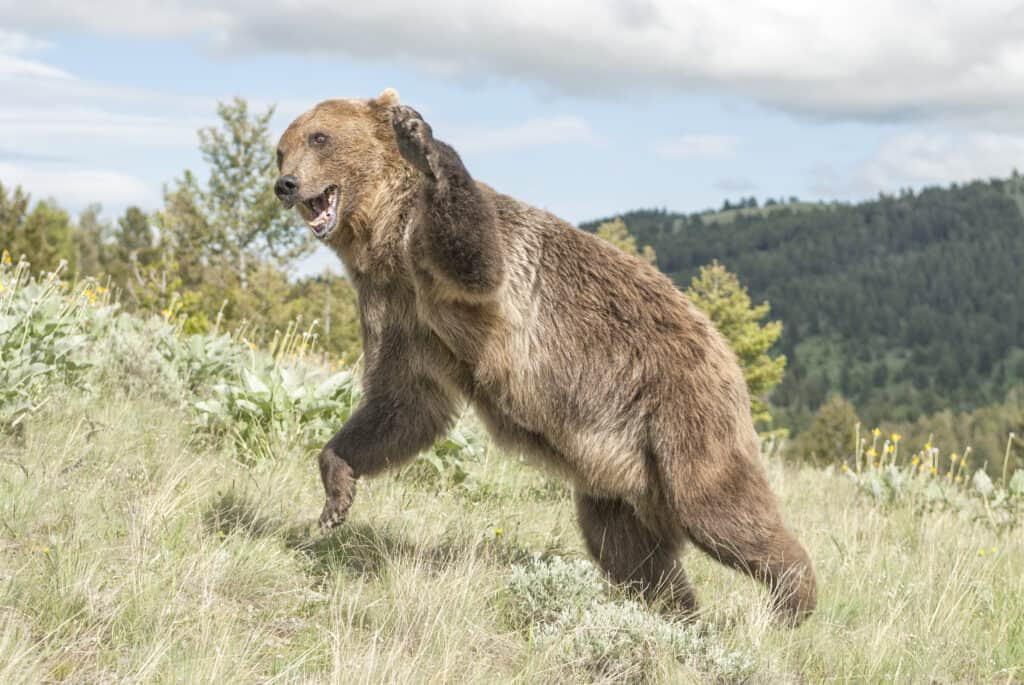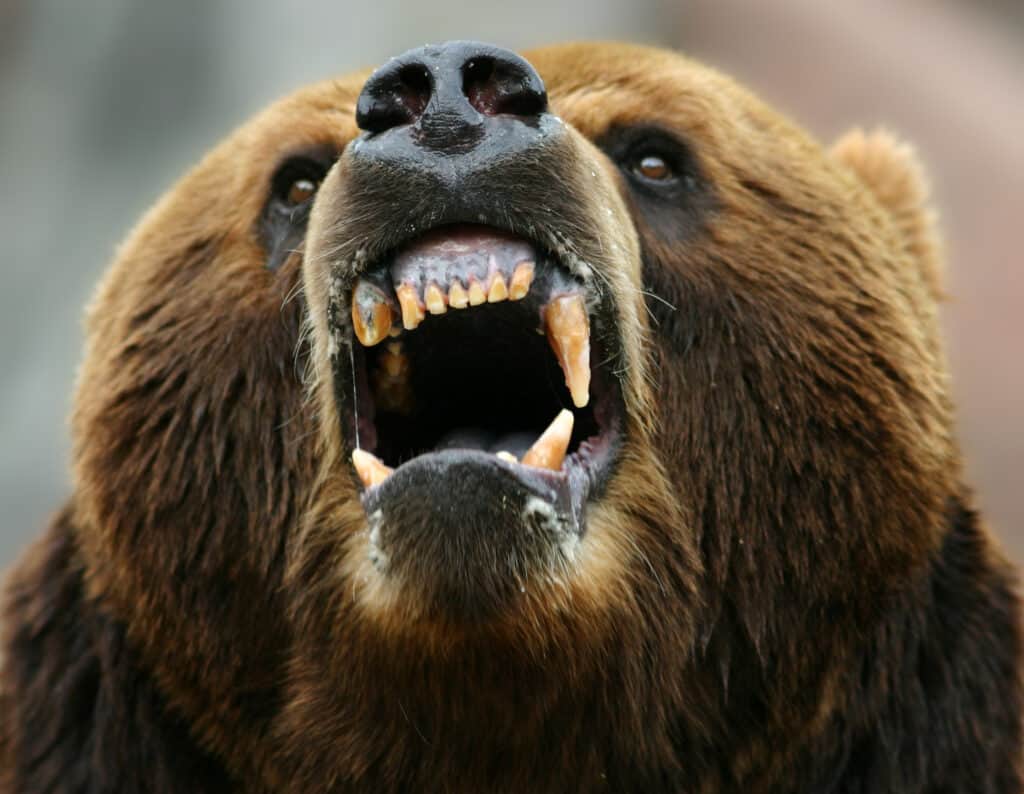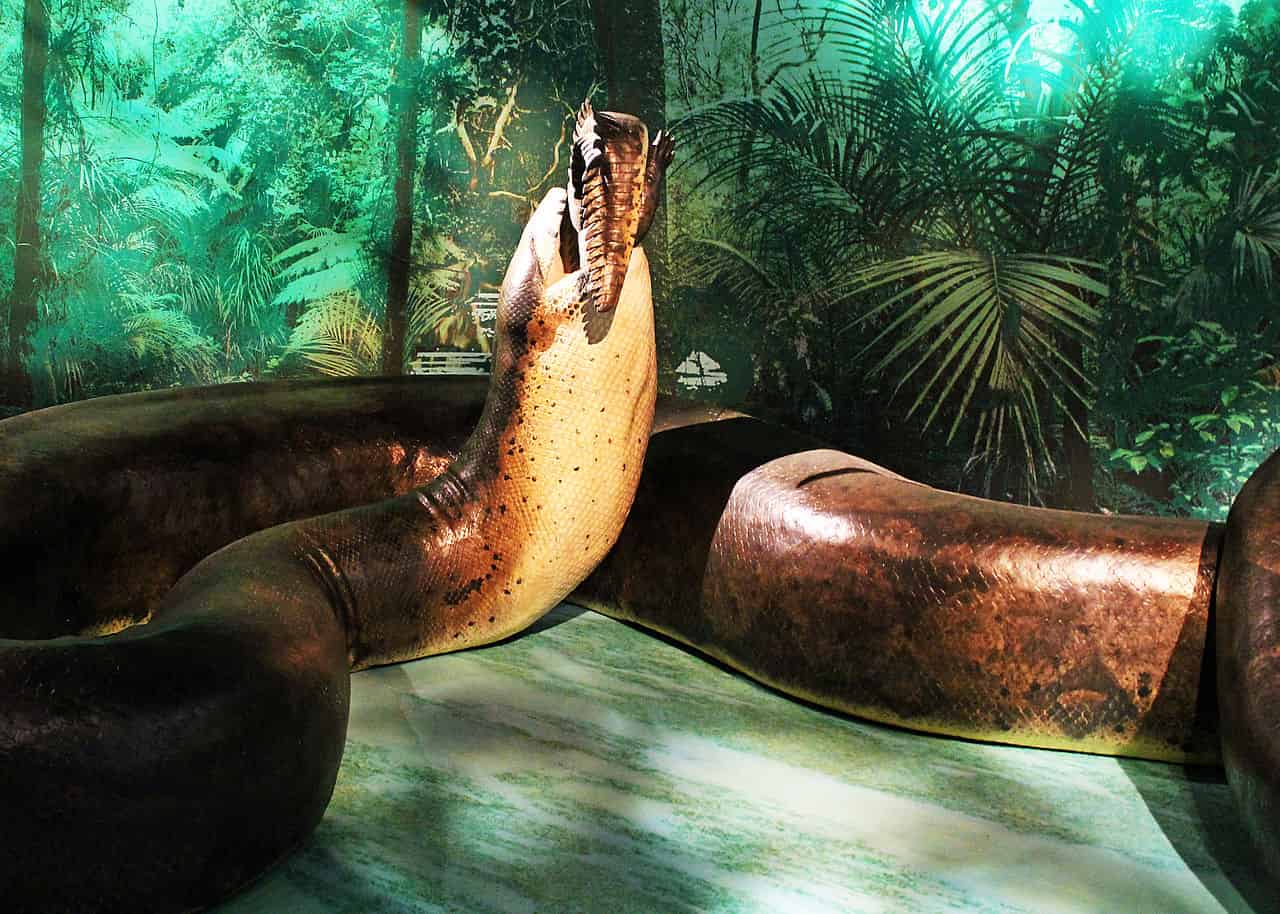Grizzly bears are tough mammals that can take down some rather large creatures. Although they’re true opportunists, they have slain creatures like moose, deer, wolves, and humans. Since so many creatures have trouble fighting this beastly bear, let’s turn back the clock and see how grizzlies would fare against an ancient creature. Today, we’re going to explore a battle between the largest snake ever vs. a grizzly bear.
The largest snake ever is the Titanoboa cerrejonensis. This snake would give a grizzly bear the fight of its life. Let’s see how it would play out.
Comparing the Largest Snake Ever and a Grizzly Bear
| Largest Snake Ever | Grizzly Bear | |
|---|---|---|
| Size | -Weight: Average weight of about 2,500 pounds –Length: 40-50 ft | -Weight: Usually weighs between 600 and 700 pounds, up to 1,200 pounds -Height: Anywhere between 3 and 4.5 feet at the shoulder -Length: Can measure 7 to 10 feet |
| Speed | – Perhaps 5 to 10 mph in the water based on estimates from anacondas | – 30 to 35 mph when closing in on prey – Can swim between 4 and 6 mph |
| Defenses | – Large, thick body is hard to bite – Would hide in swampy, shallow water making it hard to find – Can easily sense the presence of nearby prey with pit organs or by detecting vibrations – Skin color could help it hide in tall brush | – Their large, thick bodies make it hard for creatures to land fatal blows – Dense fur, thick skin, and fat layers physically protect the bear – Uses a threat display to scare prey away |
| Offensive Capabilities | – Had many rows of sharp teeth to help bite and anchor itself on prey – Could constrict prey and overwhelm their circulatory system, causing death | – Has claws measuring between 3 and 5 inches to slash prey – Has massive paws and innate power to smash into prey – Has a bite force of 975 PSI along with 2-3-inch-long teeth – Uses a multi-faceted mauling attack to kill prey by biting, slashing, smacking, and shaking |
| Predatory Behavior | – Probably was an ambush predator that waited by the water’s edge to attack – Could have been an opportunistic, piscivorous hunter | – Opportunistic predators that prefer to forage and scavenge than hunt |
What Are 3 Key Differences Between the Largest Snake Ever and a Grizzly Bear?
The greatest differences between the largest snake ever and a grizzly bear can be found in their morphology, size, and attack methods. The Titanoboa was a very large constrictor snake weighing up to 2,500 pounds and measuring up to 50 feet long that ambushed prey from below the waterline at the water’s edge. Meanwhile, grizzly bears are large quadrupedal mammals that can weigh up to 1,200 pounds and grow up to 10 feet long. They viciously attack prey that they find while exploring their environment using teeth, claws, and raw power.
These differences are significant and will greatly affect the fight. However, they are not the only things that we need to pay attention to when determining which of them would win this epic battle.
What Are the Key Factors in a Fight Between the Largest Snake Ever and a Grizzly Bear?
Some of the most impactful elements of this fight can be found in the size, speed, and attack methods of the largest snake ever and the grizzly bear. Yet, we can’t only look at those facets of this battle to determine the winner.
We’ll examine five overarching factors that would play a role in the battle, figure out which animal has the advantage in each one, and then use a combination of that data along with some educated guesswork to name a winner!
Largest Snake Ever vs. Grizzly Bear: Size
The largest snake ever, Titanoboa, was much larger than any grizzly bear. The largest grizzly bear ever found weighed about 1,200 pounds. These bears usually stand about 3 feet tall at the shoulder, but they can get larger. Often, they measure between 7 and 10 feet long.
Meanwhile, the Titanoboa weighed about 2,500 pounds or more and measured about 40 to 50 feet in length. That is an incredibly large, thick reptile that could have had a diameter of about 3 feet in its middle. Their skulls were about 16 inches long, and it’s believed they could spread their jaws over 4 feet wide when consuming large prey!
The largest snake ever has the size advantage in this fight.

The
Titanoboaweighed about 2,500 pounds or more and measured about 40 to 50 feet in length!
©Daniel Eskridge/Shutterstock.com
Largest Snake Ever vs. Grizzly Bear: Speed
The downside of being a very large snake is that its weight and overall size impact its mobility. On land, the Titanoboa was probably very slow. For that reason, it mostly stayed in or near water where it may have been able to swim between 5 and 10 mph based on estimates from large anacondas. It was likely slower than that, though.
Grizzly bears are large, but they’re also very fast on land. Their powerful forelegs allow them to run at speeds of 30 to 35 mph when they’re hunting prey. They can swim well, and they reach speeds of 4 to 6 mph in the water, but not for long distances.
Grizzly bears have the speed advantage in this fight.

Grizzly bears’ powerful forelegs allow them to run at speeds of 30 to 35 mph when they’re hunting prey.
©outdoorsman/Shutterstock.com
Largest Snake Ever vs. Grizzly Bear: Defenses
The largest snake ever would have been hard to spot in its environment. That factor provides it with a lot of protection. They would hide in swampy water or in vegetation where they would blend in. Furthermore, they had a host of strong senses that they could use to detect trouble heading their way. Their thick bodies could also take a lot of punishment without putting the snake out of commission in a fight.
Grizzly bears also rely on their size to keep them safe. Their bodies are protected by layers of fur, skin, and fat that can be several inches thick at times. Also, grizzly bears have a very frightening threat display that would make most creatures turn their tail and run. Lastly, grizzlies are fast enough to get away from many types of dangers.
These animals are tied for their defensive prowess.

The
Titanoboawould hide in swampy water or in vegetation to blend in.
©Dotted Yeti/Shutterstock.com
Largest Snake Ever vs. Grizzly Bear: Offensive Capabilities
Grizzly bears have powerful offensive powers. They don’t just bite or claw their prey. They use every bit of their vast power to smash, slash, bite, shake, and roll their prey around until it’s dead. Their mauling attack is enhanced by their claws that measure up to 5 inches long, teeth that measure up to 3 inches long, and their ability to get on top of their prey and attack from many directions.
Meanwhile, the largest snake ever was a bit of a one-trick predator. They would bite animals, hold them still, and wrap their body around their prey, causing their circulatory system to fail.
Grizzly bears have an advantage in offensive powers.

Grizzly bears use every bit of their vast power to smash, slash, bite, shake, and roll their prey around until it’s dead.
©PhotoBarmaley/Shutterstock.com
Largest Snake Ever vs. Grizzly Bear: Predatory Behavior
The largest snake ever was an ambush predator. Titanoboa probably waited by the water’s edge for prey to get a drink and then struck. The grizzly bear is mostly an opportunist. They’ll eat mostly plant matter, but they aren’t afraid to hunt. When they do, they’re cursorial predators that don’t always get the jump on their prey.
The largest snake ever has the advantage in predatory behavior.

The largest snake ever was an ambush predator.
©Ryan Quick from Greenbelt, MD, USA, CC BY 2.0, via Wikimedia Commons – Original / License
Who Would Win in a Fight Between the Largest Snake Ever and a Grizzly Bear?
The largest snake ever would probably win a fight against a grizzly bear near the water but lose the fight on land. If the fight starts with an ambush from the water, the bear will probably succumb to the constricting power of the boa. That’s especially true if the snake gets the bear into the water.
Yet, unless the Titanoboa got a great attack and coiled around the bear quickly, the grizzly could fight its way out of the hold.
If the fight started on land, the grizzly bear would have a lot of advantages against this snake. Grizzly bears are faster and smarter than the Titanoboa, and they’re incredibly powerful. Yet, there is some lingering doubt as to whether the grizzly bear could do enough damage to such an incredibly large, thick creature without getting killed in the process.
On land, the Titanoboa would probably try to flee toward the water. The grizzly is fast, but it would probably realize that attacking the snake’s thick mid-section would not work. If the grizzly manages to attack the snake’s head, though, the bear could win. Powerful smashes and bites to the skull could cause significant damage to the largest snake ever. With control over the snake’s head and primary source of attack initiation, the grizzly could maul the large snake to death. However, a single mistake that allows the snake to coil around the grizzly could prove fatal.
This is a very difficult outcome to decide since the matchups on land and water favor one creature over the other. Most likely, the Titanoboa would win in the water and the grizzly bear would win on land.
Up Next:
- Epic Battles: Grizzly Bear vs. Lion
- Epic Battles: A Massive Grizzly Bear vs. a Saltwater Crocodile
- Epic Battles: Grizzly Bear vs. the Largest Nile Crocodile
- Epic Battles: A Massive Grizzly Bear vs. A Pack of Wolves
The photo featured at the top of this post is © Michael Rosskothen/Shutterstock.com
Discover the "Monster" Snake 5X Bigger than an Anaconda
Every day A-Z Animals sends out some of the most incredible facts in the world from our free newsletter. Want to discover the 10 most beautiful snakes in the world, a "snake island" where you're never more than 3 feet from danger, or a "monster" snake 5X larger than an anaconda? Then sign up right now and you'll start receiving our daily newsletter absolutely free.
Sources
- Nature.com (1970) nature.com/articles/nature07671 / Accessed November 15, 2022
- University of Montana (1970) cfc.umt.edu/grizzlybearrecovery/grizzly-bears/biology.php#:~:text=Grizzly bears are opportunistic omnivores,fungi%2C nuts%2C and ungulates. / Accessed November 15, 2022
Thank you for reading! Have some feedback for us? Contact the AZ Animals editorial team.







